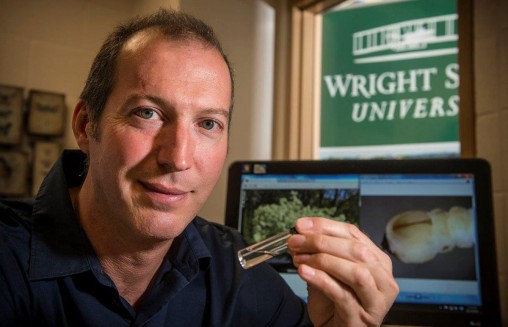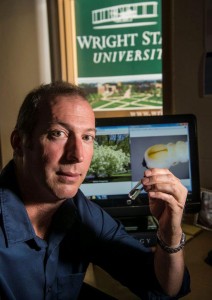
Wright State biology professor Don Cipollini suspects that the emerald ash borer, which is destroying ash trees in a large part of the country, has spread to a different tree.
The emerald ash borer, which is destroying ash trees in a large swath of the nation, has spread to a different tree, a researcher at Wright State University suspects.
Biology professor Don Cipollini, Ph.D., director of the Environmental Sciences Ph.D. Program, has found that the invasive green beetle has begun to attack white fringetree.
White fringetree is native to the United States and grows wild from New Jersey south to Florida and west to Oklahoma and Texas. It is also a growingly popular ornamental tree that has been planted in other parts of the country, including Ohio.
“It appears that emerald ash borer is eating more than ash trees,” Cipollini said. “It may have a wider host range than we ever thought in the first place, or it is adapting to utilize new hosts. This biological invasion is really something to worry about. It’s having drastic ecological and economic consequences, and you can’t always predict what’s going to happen.”
Native to Asia, emerald ash borer was introduced to the United States near Detroit in 2002. It is believed to have been in ash wood used to stabilize crates during shipping.
So far, the insect has spread in all directions, killed tens of millions of ash trees and threatens to kill most of the 8.7 billion ash trees throughout North America. It is estimated that the borer will have caused $10 billion in economic damage by 2019.
The borers attack trees by laying their eggs on the bark. The serpentine feeding galleries of the larvae inside the bark disrupt the flow of nutrients and water and starve the tree.

Don Cipollini, who has studied emerald ash borer for nearly 10 years, presented his findings to government officials and researchers at an emerald ash borer research review meeting Oct. 15.
There are efforts to try to save ash trees from the borer. Pesticides can be injected into the trunk or poured into the soil around the tree and taken up by the roots. And there have been releases of parasitoid wasps, whose larvae kill the borer larvae.
“But it’s hard to stop this thing because the borer has reached such high densities,” Cipollini said. “And it is now spreading to parts of the country where white fringetree grows.”
White fringetree, a relative of ash, is a deciduous shrub or small tree that can grow up to 30 feet tall. It has white flowers and a purple, olive-like fruit. It is known for its relative lack of pest and disease problems and has never been reported as a host to wood borers related to emerald ash borer.
Cipollini, who has studied emerald ash borer for nearly 10 years in his position at the Dayton, Ohio university, has been working with colleagues to come up with new strains of ash trees that would be resistant to the insect. With colleagues and students, he has co-authored seven publications on the insect, with several others in review or preparation.
He discovered that borers were also attacking white fringetree in August when he acted on a hunch.
Cipollini was examining some white fringetrees that had been planted by the Yellow Springs Tree Committee near his home in the southwestern Ohio village when he spotted a telltale borer exit hole with the characteristic “D” shape on one of the trees.
“I walked up to the tree, saw the hole right in front of my eyes and said, ‘Oh my gosh, there it is,’” he recalled.
He got permission from the committee to peel back the bark, discovered what appeared to be the typical feeding gallery of emerald ash borer and determined that attacks on this tree had begun at least two years earlier. He later found similar infestations in another white fringetree in Yellow Springs, one at Cox Arboretum in Dayton and one at Ferncliff Cemetery in Springfield.
Cipollini collected the larvae, took them back to his lab and put them under the microscope. The larvae were consistent with those of emerald ash borer – from the bifurcation of the pronotal groove to the abdominal segments becoming increasingly trapezoidal. Later Cipollini was able to exhume part of a dead adult beetle from the tree that failed to emerge two years ago.
He then sent a larva and the adult specimen to experts at the Animal and Plant Health Inspection Service (APHIS) and the Agricultural Research Service (ARS), arms of the U.S. Department of Agriculture. The experts agreed that critical morphological features of both the larva and the adult match those of emerald ash borer. Importantly, the adult he found proved to be male, which is essential for a positive identification.
APHIS, which investigates invasive species that impact agriculture, horticulture and forestry, would be the agency that would quarantine white fringetree to try to control the spread of the borer.
“Wild populations of this tree, along with horticultural specimens, are now seemingly under threat like ash trees are, but work on these questions remain,” Cipollini said.
He quickly wrote up a short paper on his discovery and sent it to the Journal of Economic Entomology, one of the Entomological Society of America’s main publications. Cipollini then presented his findings to APHIS officials and researchers at an emerald ash borer research review meeting on the Wooster campus of The Ohio State University on Oct. 15.
“I am grateful to be in a position at Wright State University that affords me the academic freedom to explore,” he said. “If you have an interesting question and can find the appropriate resources, you can study it.”
Dan Herms, professor of entomology at Ohio State, said Cipollini’s discovery is significant.
“It’s the first time the emerald ash borer has been found colonizing another species than ash,” Herms said.
Cipollini said that if the emerald ash borer destroys white fringetree, the birds, insects and other wildlife dependent on the tree’s leaves and fruit may also be threatened.
“It’s one of these unexpected consequences of biological invasions,” he said. “Even when you think you have a handle on something and you understand what it does and what it may cause, these kinds of surprises pop up.”
Cipollini said the threat to white fringetree is the latest example of the narrowing of the plant ecosystem, which provides humans with such things as fuel, water purification and erosion control.
“It gets harder and harder for Mother Nature to handle that for us as you further and further reduce the pool of species that are present and their abundance,” he said.

 Wright State’s Raj Soin College of Business ranked among the best for entrepreneurs by Princeton Review
Wright State’s Raj Soin College of Business ranked among the best for entrepreneurs by Princeton Review  Wright State’s annual Raidersgiving draws hundreds
Wright State’s annual Raidersgiving draws hundreds  Wright State named a Best for Vets College
Wright State named a Best for Vets College  Wright State’s Boonshoft School of Medicine receives full continuing accreditation from Liaison Committee on Medical Education
Wright State’s Boonshoft School of Medicine receives full continuing accreditation from Liaison Committee on Medical Education  Wright State supports deaf and hard of hearing community with Deaf Festival
Wright State supports deaf and hard of hearing community with Deaf Festival 